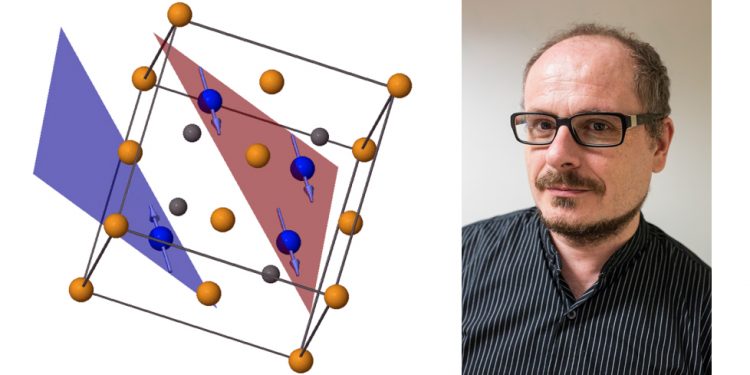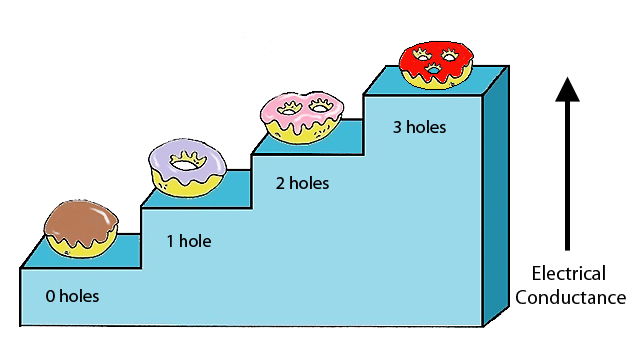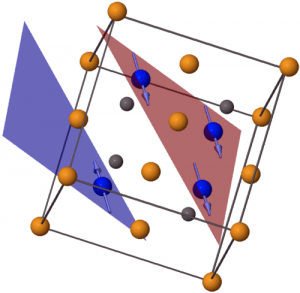
Université de Montréal scientists use neutron beams in their search for materials that could have revolutionary applications in computing technology. Their search was made possible by fundamental discoveries that were recognized by the 2016 Nobel Prize in Physics.
Source: Canadian Neutron Beam Centre (CNBC)
Contact: cnbc@cnl.ca
Images: American Physical Society; Prof. Andrea Bianchi
The 2016 laureates for the Nobel Prize in Physics were three American theorists who made surprising predictions about how some materials could behave. After Canadian physicists used neutron beams to experimentally confirm one of these predictions in 1985 (see http://cins.ca/2016/10/06/2016-nobel-prize/), the scientific world took notice of the theorists’ astounding claims. Since then, researchers began to classify materials based on these newfound behaviours, leading to more and more discoveries, especially in the last 10 years.
“It’s like a new continent has been opened for exploration and we don’t know what we’ll find,” says Professor Andrea Bianchi of the Université de Montréal. “But we see exciting possibilities for future breakthrough technology, specifically in computing.”
Bianchi, who holds a prestigious Canada Research Chair position, is one of many physicists around the world who have been aggressively exploring the properties of new classes of materials in hopes of identifying the keystone of tomorrow’s quantum computers, supercomputers, and even everyday devices. Bianchi’s research is particularly exciting because it focuses on identifying new materials with spintronic applications.
What makes spintronics so interesting is its ability to completely overhaul how electronic devices operate. While ordinary electronics use the movement of electrons to transfer information, spintronic devices use the direction of an electron’s spin for that purpose. Early spintronic devices are already on the market, and the coming generations of spintronic technologies could represent major breakthroughs in the processing speed and memory density of computers. (For more on spintronics, see http://cins.ca/tag/spintronics/.)
Recent developments in spintronics, including those gained through Bianchi’s research, are closely linked to some of the most exciting new discoveries in materials physics—including the theoretical breakthroughs recognized by the 2016 Nobel Prize. For instance, one of the insights put forth by the prizewinners was that certain materials have unique properties that can only be identified by examining the entire object (as opposed to looking at just a small sample of it). This theory disrupted longstanding scientific thought, which mistakenly held that the fundamental properties of any given material could be explained by how the molecules interacted with others in its molecular neighborhood. As a result, when the prizewinners’ theories were validated, our knowledge of fundamental physics changed forever.
To better understand this groundbreaking concept, consider the three most common states of matter: solid, liquid, and gas. If you were to examine a tiny bit of each, no matter how small, it would still look and act like either a solid, a liquid, or a gas. That’s because its state is determined by how its molecules interact with their nearest neighbours. But there are other properties of the material that you wouldn’t be able to observe this way.
For instance, if the solid material you were examining was a donut, you wouldn’t be able to tell if it had a hole (or even if it was jelly-filled) by simply looking at a piece of the dough under a microscope. In addition, since there is no such thing as a half‑hole, the number of holes can only have discrete values, such as 0, 1, 2, or 3—but never, say, 1.5. (A scientist would say that the number of holes is ‘quantized.’)

All objects with the same number of holes can be said to be in the same topological state, while objects with different numbers of holes (represented here as jelly-filled donuts, regular donuts, figure-eight donuts, and a three-holed donut) all represent different topological states. (Image: CNBC)
As the 2016 prizewinners demonstrated, the electrons in certain kinds of materials can organize collectively to produce properties that, like the number of holes in a donut, can only be identified by examining the object as a whole. What’s more, when measured, these properties can only take on certain discrete or quantized values, and these values are independent of the local interactions between nearby molecules. Materials with such unusual behaviours are called ‘topological’ materials.
One of the unusual behaviours seen in some topological materials relates to how they conduct electricity. Normal materials either conduct electricity or they don’t. Even a semi-conductor, whose ability to conduct electricity can be turned on and off, is either a conductor or an insulator at any given time—never both. But topological insulators can conduct and insulate simultaneously; indeed, they conduct electricity along their surface while resisting electricity everywhere else.
Topological insulators could be useful in spintronics applications for two reasons. First, the conducting electrons are ‘spin polarized,’ meaning that the directions of their spins are fixed in one of two possible directions, which in turn could be used to encode information in a device. Second, they would be incredibly resilient, since their key properties are produced by the fundamental physics of the material.
“Attempts have been made to make devices that take advantage of the surface properties of other materials, but these attempts usually fail because surface properties are too easily ruined by defects or impurities,” explains Bianchi. “But the surface properties of topological insulators are nearly indestructible.”
Conceptually, the potential of topological insulators is so great that researchers have been trying to identify different variations of these materials for years. For instance, in 2010, a group of American physicists predicted the existence of an ‘antiferromagnetic’ topological insulator (AFTI). This sparked a new wave of research, as AFTIs would have the ability to conduct electricity along their surfaces while easily switching it on and off, thereby potentially imparting transistor-like qualities if used in a device.
Positively identifying an AFTI is a challenging task, as it requires a variety of experiments to fully characterize the candidate material’s properties. In 2011, one American research team used x‑ray diffraction to examine a compound of gadolinium, bismuth, and platinum (GdBiPt)—a material that showed good potential to be an AFTI. However, the researchers’ x‑ray method couldn’t determine one key fundamental property: the directions of the magnetic fields around the compound’s electrons.
When x‑rays fail to provide such information, scientists generally turn to neutron scattering because it is uniquely suited to pick up on the directions of magnetic fields. At that point in time, however, the presence of gadolinium in the compound deterred the American researchers from further exploration, as gadolinium had the reputation of being extremely difficult to analyze using neutrons. Fortunately, this was about the time that Dominic Ryan of McGill University was conducting experiments at the Canadian Neutron Beam Centre (CNBC) to prove that yes, neutron scattering can be used successfully on gadolinium compounds (see http://cins.ca/2013/07/01/discovery-2/).

Illustration of GdBiPt’s atomic and magnetic structures, which could only be determined using neutron scattering. The anti-parallel alignment of the magnetic fields (arrows) around the gadolinium atoms (blue) in the two coloured planes is one of the prerequisites for an AFTI. (Image: APS)
Using the methods pioneered by Ryan, Bianchi’s investigations picked up where the previous exploration of GdBiPt ended. In experiments published in 2014, Bianchi’s research team used the CNBC to find the missing information about the directions of GdBiPt’s magnetic fields. The results, which confirmed the compound’s status as a strong AFTI candidate due to the anti-parallel alignment of its magnetic fields, sparked renewed interest in exploring this topological material.
But the road to discovery often takes unexpected turns, and experiments published in 2016 by American scientists suggest that GdBiPt might not be an AFTI after all. Instead, it might belong to a new class of topological materials called Weyl semimetals, which was just discovered in 2015. Nevertheless, like AFTIs, Weyl semimetals might be useful in spintronic applications. Subsequent examinations of GdBiPt conducted by American and Chinese physicists using neutron beams at an American laboratory have recently provided more insight into this compound’s fundamental properties.
Meanwhile, the search for AFTIs continues. The focus has remained on materials similar to GdBiPt, and the field of possibilities is constantly being re-evaluated. For example, Bianchi’s team used neutron beams at the CNBC to falsify a prediction that a similar neodymium compound, NdBiPt, might be an AFTI. Perhaps one of the most promising at the time of this writing is a compound made of holmium, palladium, and bismuth (HoPdBi). Using neutron beams at a French laboratory, a team of Polish physicists examined HoPdBi and confirmed that it has one key property required of an AFTI, although further experiments are needed to determine whether it meets the other requirements.
“While we need a range of tools to unravel the mysteries of these new topological materials, neutron beams remain essential because they give us critical details that we just can’t get any other way,” concludes Bianchi.
